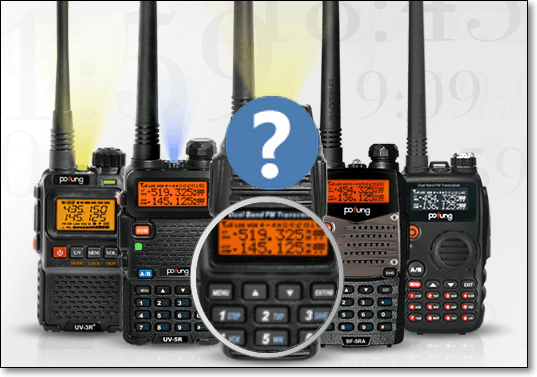 What’s the difference between the Baofeng UV-3R, UV-5R, UV-82, UV-B5/UV-B6, etc.?
What’s the difference between the Baofeng UV-3R, UV-5R, UV-82, UV-B5/UV-B6, etc.?

In China, there is a lot of passing around of designs, tweaking, improving upon, and re-branding.
In 2011 a company called VeroTelecom brought out a “UV-3R” radio which was picked up on by Baofeng and brought to a Western market where, eager for a bargain, it went down a storm. A year later, TYT made the TH-UV5R which again was picked up by BF and released in the West as the UV-5R. Initially meant as cheap SDR business band HTs, hams quickly noticed that they have a proper VFO making them perfect for our uses.
A year after that, Baofeng (now Pofung, internationally) designed and released their own radios based on the UV-5R; the UV-82, a more “professional” version of the UV-5R, and the UV-B5/UV-B6 with an entirely redesigned and far more selective RF front-end.
The first two are pants as radios go, with all kinds of weird bugs, overloading problems, and less-than-adequate phase noise and harmonic suppression performance.
The UV-82 crossed the line from “meh” into “good” with performance being on par with existing radios twice the price.
The UV-B5 blew all existing Baofengs out of the water, with on-air performance nearly matching that of Yaesu’s lower end Vertex (VX-**) series handhelds which cost five times the price. It has its quirks but for basic repeater ragchewing its value for money can’t be beaten.
The great thing is, all these radios can be had for under $35 if you know where to look: while not perfect they are a great way to get started, or to dip your toes into the hobby without spending too much. However, if you have the disposable income to put down on a more expensive radio, do – the Yaesu FT-60R is a good start.
If you’d like to read more about the differences between some of these radios, I go into a little more detail here.













I own one of the first generation Baofeng UV-3R. Honestly, I never much cared for it. Other than being amazingly small, it was a pain to program manually as it lacked a keypad. A year or so later, the speaker just stopped working. Can’t say I’d be anxious to own another one.
Well, I have a pair of UV-3Rs, and a UV-5R+. All great radios. For the price, if one gets trashed/lost/stolen/etc, not a big deal. The UV-3R is great as a “pocket” radio for travel is space and weight are tight. In metro areas, the UV-3R is more than sufficient for local (10 – 15 miles) repeaters. Also, I have mine programmed for local Coast Guard 16 and 22A (I live near the ocean), fire/police repeaters, and NOAA weather channels.
ONLY problem I have had is reliability of the UV-5R+ charger — I am on the third one, but am told the TYT charger is of better quality, so just ordered one up.
The “camera battery” in the UV-3R is very handy — you can keep and extra one pre-charged, so avoid having to take the charge along for short trips. The lithium ion batteries have very little self-discharge for a reasonable time — week, perhaps.
With a third party antenna, things can be much better — any of the Nagoya ones seem to be fine, IMHO. For the price, you can’t beat them.
If any of these “bite the dust,” then I’ll get one of the newer models.
73 /paul W3FIS
It’s probably worth mentioning the new models coming down the pipe:
https://hamgear.wordpress.com/2015/02/23/baofeng-tech-teaser-unveiled/
http://www.brickolore.com/2015/02/baofeng-tech-anytone-tech.html
I have a UV-5R. Heck, for $35… the little runt can be used as an FM radio if you don’t think it’s worth the price for hamming. However, I have connected mine to my massive vertical and folks from miles around are amazed at the little $35 HT that sounds like a $235 radio.
A little off the original train of thought here, but it might interest someone. I have an FT-60 that I had quite a bit of battery life problems with in the beginning. I don’t use it much, but whenever I would need it the battery was dead or very low, necessitating a charge at a time that was never convenient. My solution to the problem was to install a Li-ion pack, FNB-83, 7.4V 2000mah. I’ve now been using this mod for about 2 years, the voltage whenever I turn it on has never been below 8V, and whether I use it or not I charge it up about every 3 months or so. Also, it will now transmit while plugged in and charging, since the battery pack has it’s own power port and charger, which came with the battery pack. If the darn thing just stood on its bottom a little more stable than it does it would be nice, but that’s about my only complaint. I liked my FT-50 better, but the charging port failed and Yeasu wouldn’t support it any more because of age, so I modified the charge port (not an easy job) and now use it for a monitor, or use a AA cell non-rechargeable battery pack for it, which can be rather expensive if you have to do much transmitting. Hope this info helped someone.
We bought 60 Beefing UV5r a year ago and have yet to have the first failure. They are used in an industrial setting by our supervisory staff. I have nothing but praise for this little workhorse.